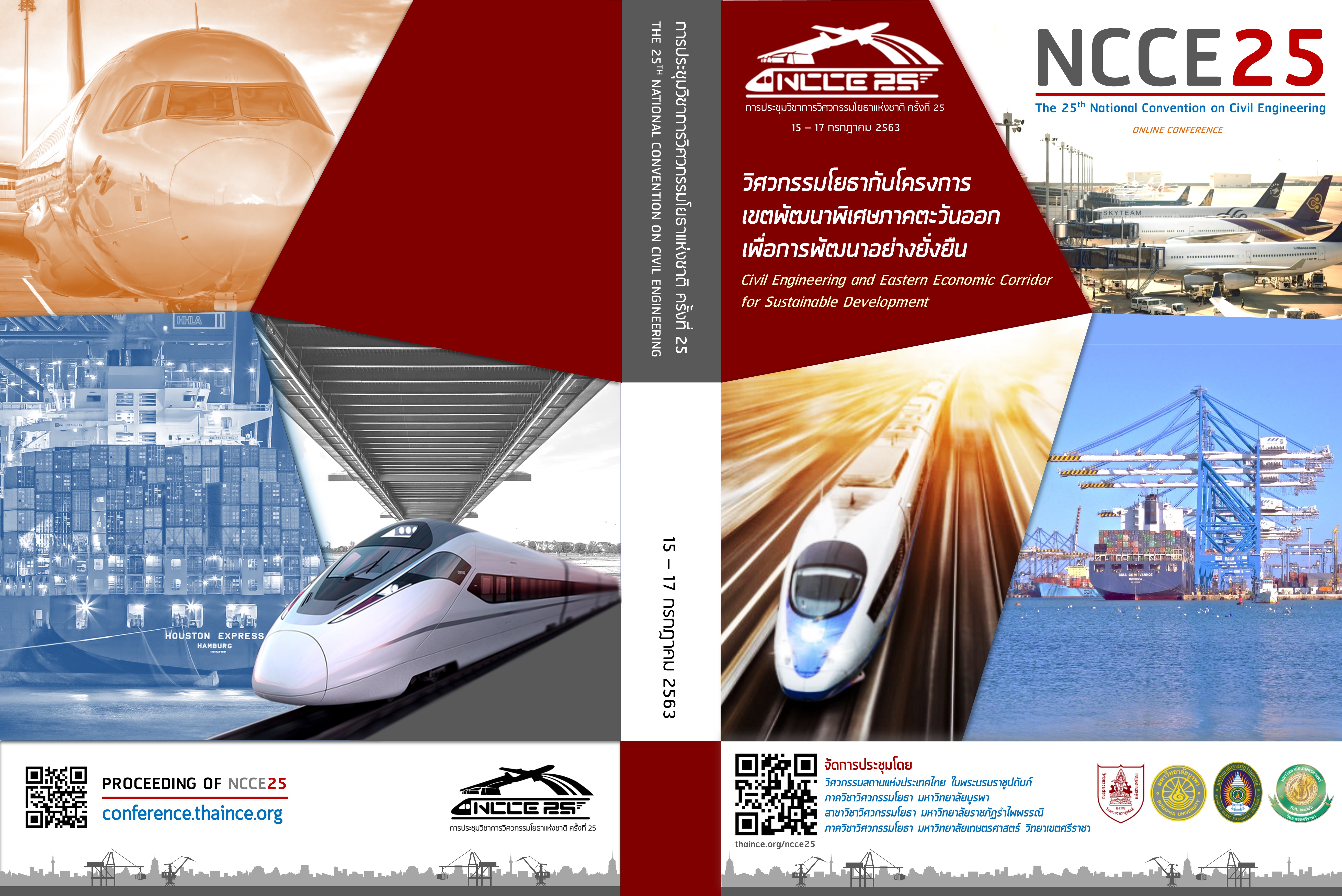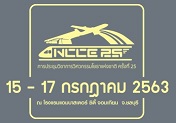Effect of Temperature and Relative Humidity on Chloride Threshold of Concrete
Keywords:
ปริมาณคลอไรด์วิกฤต, ระยะเวลาเริ่มเกิดสนิม, อุณหภูมิ, ความชื้นสัมพัทธ์, เถ้าลอย, ซิลิก้าฟูมAbstract
This paper aims to study the effect of temperature and relative humidity in environment on threshold chloride content of concrete. The temperature of environment at 30°C and 50°C and the relative humidity of environment at 30% and 90% were studied. In this study, fly ash to binder ratios were kept at 0.20 and 0.40. Silica fume to binder ratio of 0.075 was used. Water to binder ratio of 0.50 was used for all mixes. From the experimental results, at constant relative humidity of 90%, concrete exposed to 30°C of temperature had longer depassivation time than concrete exposed to 50°C of temperature, but had lower threshold chloride content. At constant temperature of 50°C, concrete exposed to 30% of relative humidity had longer depassivation time than concrete exposed to 90% of relative humidity, but also had lower threshold chloride content. When steel corrosion index (CRIDT) was considered, concrete exposed to low temperature environment had higher CRIDT than concrete exposed to high temperature environment. Concrete exposed to low relative humidity environment had also higher CRIDT than concrete exposed to high relative humidity. Concrete containing fly ash with the replacement of 40% had the highest CRIDT. Concrete containing silica fume had higher CRIDT than cement-only concrete.
Downloads
References
[2] Tangtermsirikul, S. (2003). Durability and mix design of concrete (1st edition). Pathum Thani: Thammasat University, Rangsit Campus.
[3] Jones, M.R., Dhir, R.K. and Gill, J.P. (1994). Concrete surface treatment: Effect of exposure temperature on chloride diffusion resistance. Cement and Cement Research, 25(1), pp. 197-208.
[4] Gastaldi, M. and Bertolini, L. (2014). Effect of temperature on the corrosion behaviour of low-nickel duplex stainless steel bars in concrete. Cement and Concrete Research, 56, pp. 52-60.
[5] Angst, U., Elsener, B., Larsen, C.K. and Vennesland, Q. (2009). Critical chloride content in reinforced concrete - A review. Cement and Concrete Research, 39, pp. 1122-1138.
[6] Tuutti, K. (1982). Corrosion of steel in concrete. Swedish Cement and Concrete Research Institute, Stockholm.
[7] American Society for Testing and Materials (ASTM). (2000). ASTM C876, Standard test method for half-cell potentials of uncoated reinforcing steel in concrete.
[8] American Society for Testing and Materials (ASTM). (2000). ASTM G109, Standard test method determining the effects of chemical admixtures on the corrosion of embedded steel reinforcement in concrete exposed to chloride environments.
[9] British Standards (BS). BS 1881-116, Method for determination of compressive strength of concrete cubes.
[10] American Society for Testing and Materials (ASTM). (2000). ASTM C1152, Standard Test Method for Acid-Soluble Chloride in Mortar and Concrete.
[11] Ann, K.Y. and Song, H.W. (2007). Chloride threshold level for corrosion of steel in concrete. Corrosion Science, 49, pp. 4113-4133.
[12] Thomas, M. (1996). Chloride thresholds in marine concrete. Cement and Concrete Research, 26, pp. 513-519.
[13] Thomas, M.D.A. and Matthews, J.D. (2004). Performance of pfa concrete in a marine environment-10 year results. Cement and Concrete Composites, 26, pp. 5-20.
[14] Hussain, S.E. and Rasheeduzafar, S. (1994). Corrosion resistance performance of fly ash blended cement concrete. ACI Material Journal, 91, pp. 264-273.
[15] Bamfort, P.B. (1999). The derivation of input data for modelling chloride ingress from eight-years UK coastal exposure trials. Magazine of Concrete Research, 51, pp. 87-96.
[16] Dehwah, H.A.F., Austin, S.A. and Maslehnddin, M. (2002). Chloride-induced reinforcement corrosion in blended cement concretes exposed to chloride-sulphate environments. Magazine of Concrete Research, 54, pp. 355-364.
[17] Arya, C., Buenfeld, N.R. and Newman, J.B. (1990). Factors influencing chloride-binding in concrete. Cement and Concrete Research, 20, pp. 291–300.
[18] Dhir, R.K. and Jones, M.R. (1999). Development of chloride-resisting concrete using fly ash. Fuel, 78, pp. 137–142.
[19] Kayyali, O.A. and Haque, M.N. (1995). The Cl/OH ratio in chloride-contaminated concrete - a most important criterion. Magazine of Concrete Research, 47, pp. 235–242.
[20] Page, C.L. and Havdahl, J. (1985). Electrochemical monitoring of corrosion of steel in microsilica cement pastes. Materials and Structures, 18, pp. 41–47.
[21] Page, C.L. and Vennesland, Ø. (1983). Pore solution composition and chloride binding capacity of silica fume-cement pastes. Materials and Structures, 19, pp. 19–25.
[22] Larsen, C.K. (1998). Chloride binding in concrete. Thesis, Report No 1998:101, Norwegian University of Science and Technology, NTNU.
[23] Byfors, K. (1987). Influence of silica fume and fly ash on chloride diffusion and pH values in cement paste. Cement and Concrete Research, 17, pp. 115–130.
[24] Glass, G.K. and Buenfeld, N.R. (1997). The presentation of the chloride threshold level for corrosion of steel in concrete. Corrosion Science, 39(5), pp. 1001–1013.
[25] Shehata, M.H., Thomas, M.D.A. and Bleszynski, R.F. (1999). The effects of fly ash composition on chemistry of pore solution in hydrated cement pasted. Cement and Concrete Research, 29, pp. 1915-1920.
[26] Diamond, S. (1981). Effects of two Danish fly ashes on alkali contents of pore solutions of cement-fly ash pastes. Cement and Concrete Research, 11, pp. 383-394.
[27] Manera, M., Vennesland, Q. and Bertolini, L. (2008). Chloride threshold for rebar corrosion in concrete with addition of silica fume. Corrosion Science, 50, pp. 554-560.
Downloads
Published
How to Cite
Issue
Section
License
บทความทั้งหมดที่ได้รับการคัดเลือกให้นำเสนอผลงานในการประชุมวิชาการวิศวกรรมโยธาแห่งชาติ ครั้งที่ 25 นี้ เป็นลิขสิทธิ์ของ วิศวกรรมสถานแห่งประเทศไทย ในพระบรมราชูปถัมภ์



